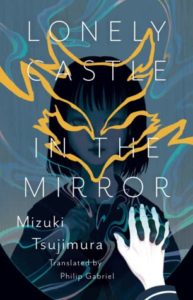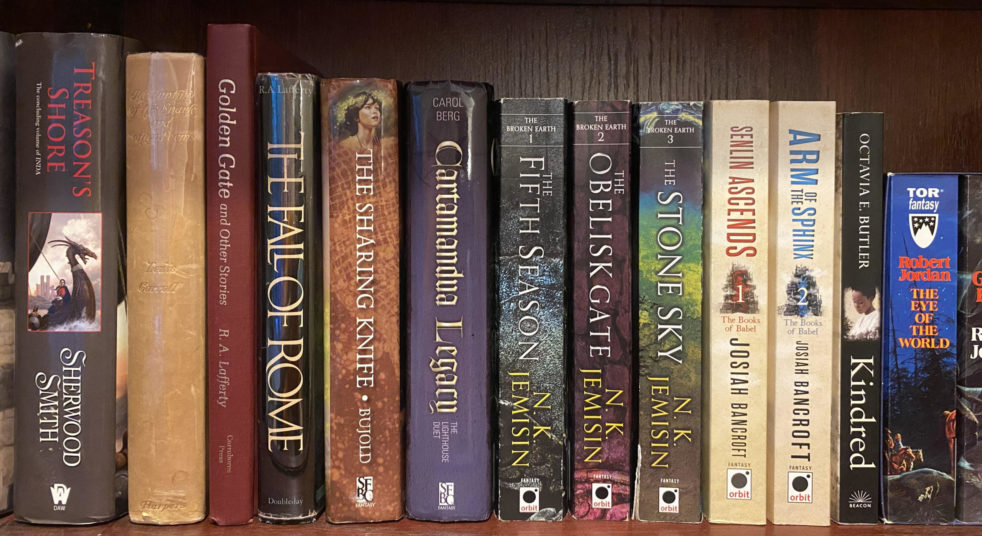
This review is based on an eARC (Advance Reading Copy) provided by the publisher via NetGalley in exchange for an honest review. Lonely Castle in the Mirror will be released on October 18, 2022.
Lonely Castle in the Mirror wasn’t at all on my radar coming into this year, but apparently it’s been popular enough in Japan to see manga and anime adaptations, along with translations into several other languages. Add in an interesting premise and my ongoing goal to branch out from the American-published mainstream, and I decided to take a shot on Philip Gabriel’s English translation of Mizuki Tsujimura’s hit novel.
Lonely Castle in the Mirror is written primarily from the perspective of Kokoro, a first-year junior high student who had been unable to bring herself back to school after the bullying she experienced in her first weeks in a new environment. But when she finds a portal to a mysterious castle, populated with six other kids also eschewing the traditional junior high, it could be the fresh start she needed. And if she finds the magic key that would grant her one free wish, perhaps it would be enough to solve her bullying problem as well.
Lonely Castle in the Mirror is a school novel without the school. The book is split into three parts, representing the three terms of the Japanese school year, with each month serving as a chapter. The first half sees fairly little plot progression, with seven reticent adolescents getting used to a new environment and trying to feel each other out. The structure should be familiar to readers of other works set in fantasy academia, but Lonely Castle in the Mirror lacks the magical education that so often fills those early sections. Rather, there’s a lot of introspection with a dash of video games in an opening with an extremely small-scale feel.
And once the plot does get going, there’s no world-ending threat to defeat. The story does build to a tense, exciting conclusion, but the cast doesn’t have to save anything other than each other—Lonely Castle in the Mirror is a story about moving forward in the wake of personal struggles, and it never pretends to be anything else.
And it is absolutely excellent at being what it is. The description of bullying is true-to-life without reveling in the details, eschewing shocking descriptions of inhuman behavior in favor of a focus on the debilitating anxiety that can follow even everyday social toxicity. We mostly see through Kokoro’s eyes, but we glimpse the backstories of every major character, and their hesitancy to trust potential new friends—not to mention authority figures—flows perfectly from that internal turmoil. And when they finally do begin to open up, it doesn’t come easily, with what seems on the surface a simple task taking on such tension that it might as well be saving the world, all leading to a conclusion that’s as touching as it is thrilling.
The portal scenario that underlies the story doesn’t get enough explanation to satisfy those who need to understand any departure from the ordinary, but there are other mysteries wrapped within it that do yield immensely satisfying revelations. If the mystery were the point, it wouldn’t be enough. But as a supplement to the central story of adolescents finding a way to move forward after trauma, it’s extremely well-plotted, with those smaller mysteries providing a second major punch to the climax without detracting a bit from the main thrust of the novel.
Overall, I cannot recommend this book more highly to fans of stories about adolescent mental health who don’t mind the school novel structure. The slow pace in the first half and the unanswered questions about the underlying magic may be hard to swallow for some readers, but the book does such a good job with the central story that I personally see those as nothing more than minor complaints.
Recommended if you like: examination of the fallout from bullying, school novel structure without school novel school.
Can I use it for Bingo? It’s hard mode for Self/Indie-Published, Mental Health, Standalone, and Wibbly Wobbly Timey Wimey. It was also written by a BIPOC Author, and Family Matters.
Overall rating: 18 of Tar Vol’s 20. Five stars on Goodreads.

As you know, I loved this one. My only gripe with your review is that I think you give it too little credit – the book deals not just with bullying but with abuse and trauma in general of various kinds and how the kids are forced to deal with it by society’s failures, as well as the possibility of a better way. And as you pointed out, it’s really great at it.